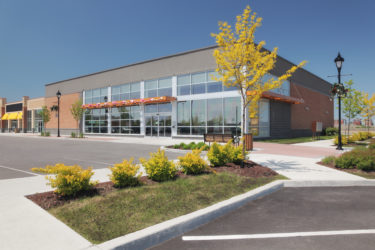1031 Exchange – DST Properties vs. NNN Properties: Case Studies

Many real estate investors choose to invest in triple net leased (NNN) properties because they are, for the most part, management-free. While the desire to get out of management is understandable, especially for real estate investors that have worked hard managing their properties for decades and now want to enjoy the fruits of their labors, investing in single-tenant NNN properties brings a variety of risks that many investors fail to consider.
Triple Net Lease (NNN) Pros and Cons
The benefits of NNN properties are well-known. Under an NNN lease, the tenant pays virtually all the operating expenses of the property. Most leases contain some exceptions, but in general, there is very little management involved for an NNN property. But, only if the tenant remains in the space and continues to pay the rent and expenses.
This is why many real estate investors decide to sell some of their management-heavy properties and exchange them into NNN properties through an IRC section 1031 Exchange. They can get out of property management (and all the headaches and time that come with them), defer their taxes, and continue to collect the income.
But, exchanging into an NNN property does not come without risks. NNN properties tend to be retail-based. Although there are some NNN office and retail properties, retail is by far the most common type of NNN property. They are also almost always single-tenant properties. So, investors in NNN properties are typically purchasing single-tenant retail.
One of the biggest risks with NNN properties is the lack of diversification. NNN properties are not cheap. Even the least expensive are priced in the multiple million-dollar ranges. That is a lot of equity to tie up into one property. If something goes wrong with it, you could lose your entire investment. Even if everything goes right, you are losing principal slowly as the lease matures. A more prudent approach is to invest in multiple properties, diversifying among locations and asset types. However, the high price for NNN properties prevents this for most real estate investors.
Since the performance of the property depends on one tenant, the single-tenant nature of NNN properties also creates additional risks. The real value in an NNN property is in the lease. The building itself is typically much less valuable without the tenant, or with a shorter lease term remaining. If the tenant vacates, breaches the lease, or even goes bankrupt, you are left with an empty building.
And yes, you could try to release the space. But that would require not only finding a suitable replacement tenant but also paying the leasing commissions and tenant improvements to get a new tenant into the property. Some individual real estate owners would not be able to do this. Consider how many former Circuity City stores are still vacant over 10 years after the once reputable retailer declared bankruptcy. Most of those stores were owned by institutional investors and they are still unable to release them.
Since most NNN properties are retail, the risks of the tenant defaulting or going bankrupt is only increased. Finding a replacement tenant is also difficult since there remains an abundance of empty retail space for any prospective tenant to choose from.
The high vacancy rate for retail property has also led to a decline in rental rates and property values. Retail is the only asset class where vacancies have risen from trough until today and the only asset types losing value. Of course, there are good reasons for this:
- The rising monolithic power of online retailers (AKA ‘The Amazon Effect’)
- The consolidation of similar companies and the resulting contraction
- The preference of Millennial and Gen-Z shoppers for online retail
- Other market-specific development and adjustments
Industrial has been booming at the same time, along with multifamily. Even with a good long-term net-lease tenant, the overall erosion of the premium for retail exposure is placing downward pressure on the asset class, allowing for more tenants to negotiate better lease terms when renewing. That is, of course, bad news for the investor/landlord. This is why values are declining overall, especially as leases get closer to maturity.
Another risk for NNN properties is the duration of the lease itself. Most NNN properties leased on a long-term basis and often contain extension options that allow the tenant to extend the lease even further. It is not uncommon to see a 20-year NNN lease with a tenant option to extend for an additional 20 years (in five-year increments).
These long-term leases are often touted as a benefit of NNN properties – stability and long-term cash flow. But again, that is not guaranteed. Anyone who owned a Sports Chalet store probably felt pretty confident in the stability of their long-term leases, until their tenants went under. Brick and mortar retailers are declaring bankruptcy more than ever. What happens to your single-tenant commercial rental if the one tenant moves out? Even worse, if the tenant is a private company, you have no way of knowing their financials, so you may never see the reversal coming until they have shuttered their operations.
Who really benefits from a long-term NNN lease? NNN leases typically provide for only small incremental increases in rent during the lease term – usually around 1% to 2% per year – which does not keep up with inflation. And that is for over 20 years or more, and longer if the tenant exercises the extension options. In comparison, consider how much apartment rents have increased in the last 20 years. The tenant in an NNN property gets the benefit of a long-term lease with rents capped at annual increases below inflation and the option to extend that rate past the original term of the lease. The benefit for landlords is that they do not have to worry about management or vacancies during the lease term, but again, only as long as the tenant continues to pay the lease.
The landlord also needs to consider what happens to the property at the end of the lease term. If the tenant leaves, how will the landlord find another tenant? How will they pay the leasing commissions and tenant improvements?
Really, the biggest benefit and the most common reason investors choose to purchase NNN properties is that they are virtually management-free. But given the risks, there are better alternatives.
Delaware Statutory Trust (DST) Advantages
With DST Properties, investors can get out of management and diversify into long-term net lease properties and other asset types to create and own a more balanced portfolio of properties. If you are not familiar with DST properties, the following is a brief description:
I cannot understand the logic of the CPAs, real estate brokers, and investors who would rather risk it all on one tenant, one property, and one location when the DST offers a more diversified option.
As I was writing this, I considered the best retail tenants like Chick-fil-A and Starbucks. These tenants are excellent and likely to remain successfully in place for a very long time. The market understands this, and therefore the cap rates for single-tenant properties with these tenants are some of the lowest in the industry (considering lease terms, locations, etc.). However, most investors are looking for a little more than 4% yield, and therefore considering everything from Walgreens and Dollar Stores to small local retailers with no significant financial strength. All of these are risky in my opinion. Take Walgreens and CVS: even if these pharmacies do not close at the location an investor owns, the overall premium they are willing to pay to rent most stores is declining. Therefore, not only are investors losing money (principal) slowly as the lease expires, but they are also losing as the demand for retail space diminishes. When it comes time to renew the lease, chances are that the rate will be lower than it is today if the tenant wants to renew.
In addition, smaller, less frequent investors are at a disadvantage when it comes to acquiring a single-tenant net-leased property. They are just unable to compete with institutional buyers for the best offerings. Yet CPAs and real estate brokers often steer clients into NNN properties, when DSTs would offer them greater protection and higher-quality properties.
DSTs offer investors the option of purchasing properties of almost any asset type, including multifamily, industrial, office, self-storage, hospitality, medical facilities, and yes, even NNN properties. Most NNN properties are portfolios of several NNN properties with different tenants. By investing in an NNN DST with multiple properties, the investor is able to diversify while still purchasing NNN properties.
Why put all of your money into one property with one tenant when you can diversify your equity into several NNN DST properties with a variety of quality tenants in different markets?
Case Studies: NNN Properties vs. NNN DST Properties
Case Study 1:
I recently had several investors do 1031 exchanges into a newly built Amazon
Distribution Center with a 13-year lease guaranteed by Amazon that was structured as a DST. The investment amounts ranged from $123,000 to $1,240,000 million.
The entire Amazon facility cost $95,900,000 million. None of my investors had anywhere near enough equity in their exchanges to purchase the property on their own. But because the property was structured under a DST, they were able to invest for as little as $100,000. One of the investors was being pressured by their real estate broker to purchase an NNN property outside of Dayton, OH. The tenant was a local diner. The broker tried to convince the client that the diner was safer than the Amazon facility. Thankfully, the client saw through it.
I do not understand how, in good conscience, brokers, CPAs, and others would advise an investor to take on all the risk of a smaller market and a less credit-worthy net-leased property with potential for significant loss of value. That same investor could choose much higher quality net-leased DST properties and diversify into multiple properties to reduce the risk even further.
Case Study 2:
A friend of one of our clients sold an apartment building in Southern California four years ago. She was interested in 1031 exchanging into several DST properties in strong locations, including multifamily properties and high-quality tenant, net-leased properties.
Her son and her broker convinced her to invest all of the proceeds in a mattress store in a small town in Oklahoma instead. Her 1031 exchange equity only covered half the price of the property, so she took on additional financing to cover the rest.
About two years ago, the tenant declared bankruptcy. The investor has since lost the property, all of her equity, and has a tax burden on top of all the other suffering she faced from this decision.
Case Study 3:
I was recently talking with a colleague who told me about one of his long-time investment friends who recently sold an apartment building he had held for 40 years and had $2,000,000 million at the accommodator. The investor’s CPA told him not to invest in a DST because “they are hard to get out of.”
The investor ended up buying a single dollar store in a small town in Oklahoma or Arkansas. I have heard this a lot and it makes me cringe knowing I certainly would not want to do this with my own money. I would feel even worse if one of my family members or friends made a decision like this.
Identifying High-Quality NNN DST Properties
Here are some of the factors that differentiate the best NNN DST properties from the single NNN properties that your CPA or real estate broker may be pushing you to invest in:
- Location: Many single-tenant NNN investors depend on the strength of the tenant rather than looking at overall market factors. This can lead to a major loss if the market is shifting or a new development nearby is drawing away from the best retail brands. What is the property worth vacant?
- Asset Condition: An asset that is completely tailored to one brand’s architectural style can be very difficult to fill in the event of the loss of the tenant. In addition, an asset that is older or in poor repair can be difficult to fill if it is in competition with newer development options.
- Tenant: While you cannot look ahead to every possible eventuality, there are some tenants whose business model and product or service are better suited to weather market fluctuations. In addition, corporate vs. franchise can make a difference, especially in cases where a company has over-expanded and set itself up for an eventual course correction.
- Terms: Both the terms of your ownership structure and the lease terms provided to tenants can make a big difference in the long-term value of your holding. A higher-quality NNN DST asset will have optimized both sides of this equation.
My argument is that even if the single-tenant is a successful fast food store or medical dialysis property, the effect of an overall downturn in retail on single-tenant property values, vacancy rates, and rents will continue to erode value from most of these single-tenant properties — and from the investors who invest in them.
Understanding the differences between NNN properties outside of the DST structure versus NNN properties within the DST structure can put investors in a better position to make informed decisions.
Contact us to speak to one of our partners and find out how the DST structure could assist in your real estate goals.










